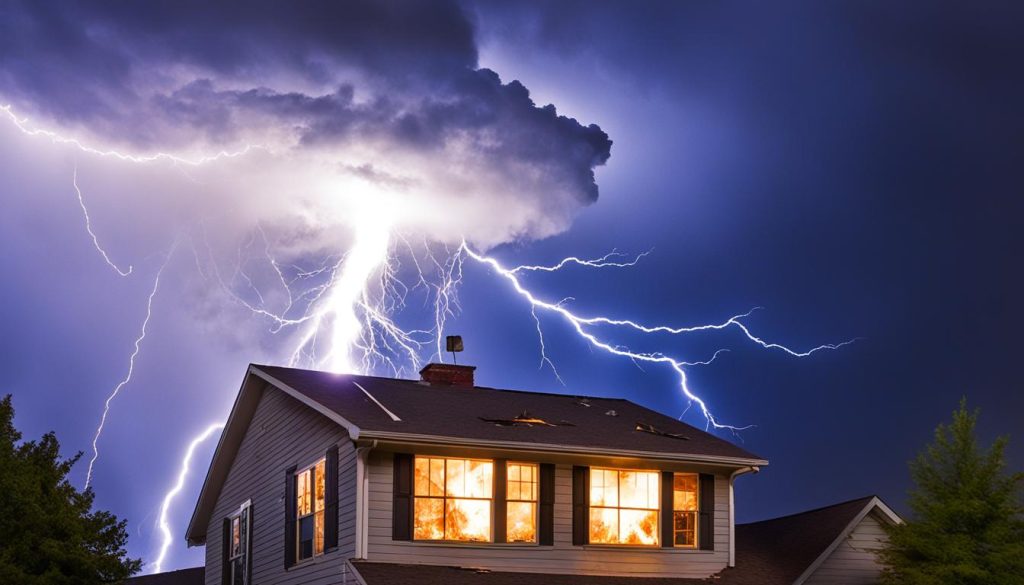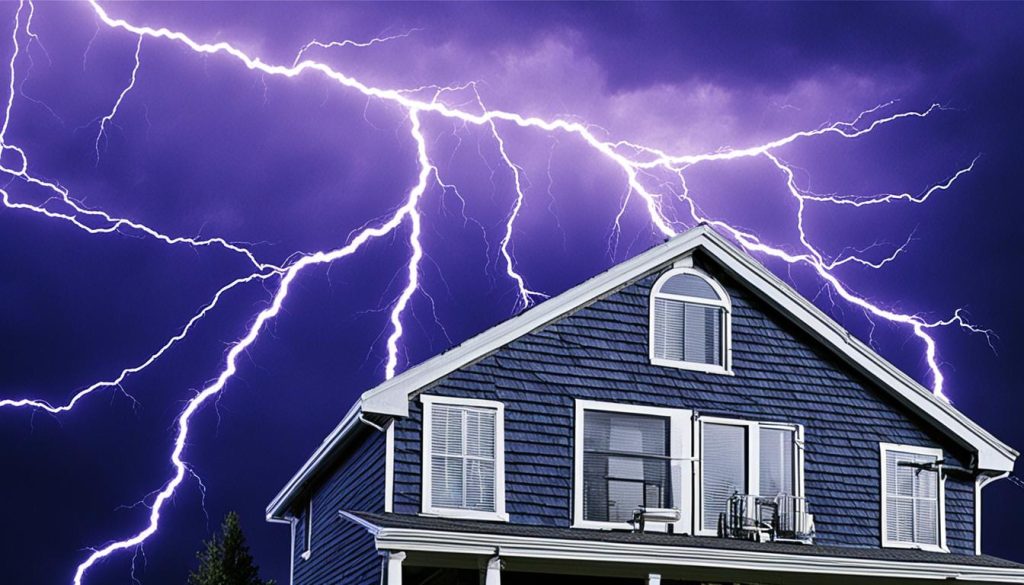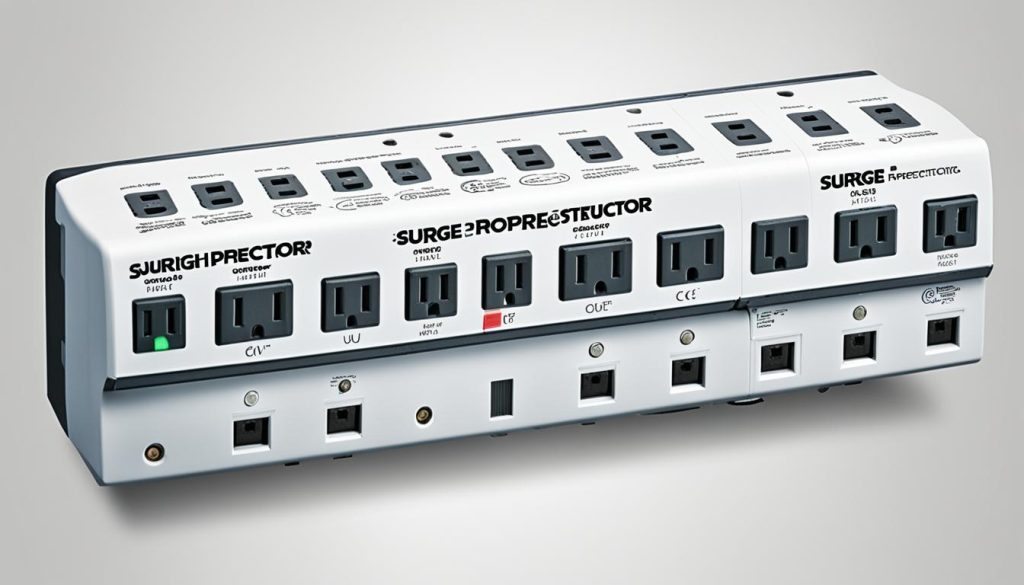Welcome to our article on whole house surge protectors and their ability to handle lightning. If you’re a homeowner concerned about protecting your valuable electronics and appliances from power surges and lightning strikes, you’ve come to the right place. We’ll explore the benefits of whole house surge protectors, their limitations when it comes to lightning, and the importance of incorporating them into your residential lightning protection system. Let’s dive in!
Key Takeaways:
- Whole house surge protectors offer protection against common power surges but cannot fully safeguard against direct lightning strikes.
- Understanding power surges and the two types of surge protectors—whole-home and point-of-use—helps in implementing an effective surge protection strategy.
- While surge protectors provide some defense against lightning strikes, the installation of a full lightning protection system is necessary for comprehensive protection.
- Whole house surge protectors are crucial for safeguarding expensive electronics and appliances from lightning-induced power surges.
- Proper installation and maintenance of surge protectors, including regular replacement, ensure their optimal performance over time.
Understanding Power Surges and Surge Protection
Power surges can cause significant damage to your electronics and appliances. These surges can be caused by external factors such as lightning strikes or downed power lines during thunderstorms, as well as internal factors like appliances cycling on and off. Understanding how power surges occur and implementing surge protection measures can help prevent costly damages.
Surge protectors are devices that monitor the flow of voltage and divert excess voltage away from your electrical devices. They work by providing a path to ground for the excess electricity, protecting your electronics from potential damage. There are two main types of surge protectors:
- Whole-home surge protectors: These surge protectors are installed at the main electrical panel and protect all the electrical devices in your home. They provide a first line of defense against power surges that enter your home through the utility lines. Whole-home surge protectors are typically installed by professionals and offer comprehensive surge protection for your entire household.
- Point-of-use surge protectors: Also known as power strips, these surge protectors are designed to protect individual appliances or devices. They are typically plugged into wall outlets and provide localized surge protection. Point-of-use surge protectors are easily accessible and can be installed by homeowners themselves.
Layering both whole-home surge protectors and point-of-use surge protectors provides the best defense against power surges. Whole-home surge protectors offer broader protection by preventing power surges from entering your home, while point-of-use surge protectors provide additional protection to specific devices.
Quotes:
“Power surges can happen anytime, and they have the potential to cause significant damage to your electronics. Investing in surge protectors can save you from costly repairs or replacements.” – Electrical Safety Expert
By implementing surge protectors, you can safeguard your electronics and appliances from both internal and external power surges. The next section will explore the limitations of surge protectors when it comes to lightning strikes and the importance of whole-house surge protection.
The Limitations of Surge Protectors and Lightning Strikes
While surge protectors play a crucial role in safeguarding our electronics and appliances from power surges, it’s important to understand their limitations when it comes to direct lightning strikes. Lightning carries immense amounts of electricity and can bypass surge protectors by leaping through the air gaps.
Lightning protection systems exist to mitigate the risks associated with direct lightning strikes. These systems, often consisting of lightning rods and grounding equipment, are designed to intercept lightning strikes and divert the electrical energy safely into the ground. However, it’s important to note that even with these protective measures in place, they cannot guarantee 100% protection from lightning strikes.
Whole house surge protectors can provide some level of protection against distant lightning strikes and electrical spikes caused by storms. They are designed to divert excess voltage and prevent it from reaching your electronics and appliances. However, it’s essential to understand that whole house surge protectors are not specifically designed to handle direct lightning strikes.
Important Points:
- Surge protectors cannot fully protect against direct lightning strikes.
- Lightning protection systems exist but cannot guarantee 100% protection.
- Whole house surge protectors offer some protection against distant lightning strikes and electrical spikes.
- It’s crucial to understand the limitations of surge protectors when it comes to lightning strikes.
Lightning Surge Protectors Comparison Table
| Feature | Whole House Surge Protectors | Lightning Protection Systems |
|---|---|---|
| Protection against direct lightning strikes | No | No (partial protection through interception and grounding) |
| Protection against internal and external power surges | Yes | No (additional surge protectors may be required) |
| Cost | Relatively affordable | Costly |
| Installation | Suitable for DIY or professional installation | Requires professional installation |

The Importance of Whole House Surge Protection
When it comes to safeguarding your expensive electronics and appliances, whole house surge protection is an absolute necessity. Power surges caused by lightning strikes can wreak havoc on your home, resulting in significant damage to sensitive devices such as home entertainment systems, computers, and more. Investing in whole house surge protectors can provide you with the peace of mind you need to protect your valuable assets.
Whole house surge protectors act as a filter, blocking any unsafe or irregular voltage from reaching your electronics and appliances. By diverting excess voltage through a grounding wire, these protectors ensure that only stable and safe electricity is delivered to your devices. This mechanism helps to prevent damage and ensure the longevity of your electronics, saving you from costly replacements or repairs.
Moreover, whole house surge protectors provide an added layer of safety for your home. By neutralizing power surges caused by lightning strikes, they minimize the risk of fire hazards and electrical malfunctions. With a whole house surge protection system in place, you can enjoy the benefits of lightning safety for your home and protect both your belongings and your loved ones from potential harm.
Benefits of Whole House Surge Protectors Against Lightning:
- Shield expensive electronics and appliances from damage
- Prevent costly replacements or repairs
- Ensure stable and safe electricity supply
- Minimize the risk of fire hazards and electrical malfunctions
- Affordable and long-lasting protection
Don’t compromise the safety of your home and the well-being of your devices. Invest in whole house surge protectors to provide comprehensive lightning protection for your valuable assets.

| Damage caused by lightning strikes | Protection provided by whole house surge protectors |
|---|---|
| Burned electrical wiring and insulation | Protects electrical wiring from excessive voltage |
| Damage to circuit boards and microprocessors | Filters out unsafe voltage to safeguard delicate electronics |
| Brick and mortar damage due to electrical fires | Reduces fire hazards by preventing electrical malfunctions |
Different Types of Surge Protectors
When it comes to protecting your appliances and electronics from power surges, there are two main types of surge protectors to consider: point-of-use surge protectors and whole-home surge protectors.
Point-of-use surge protectors, commonly known as power strips, are designed to protect individual appliances. They are equipped with built-in surge protection technology that diverts excess voltage away from your devices, preventing damage. Point-of-use surge protectors are convenient and easy to use, and they can be found in most electronics stores. They are a great option for protecting specific appliances like computers, televisions, and gaming consoles.
Whole-home surge protectors provide comprehensive protection for your entire household. These surge protectors are installed at the electrical panel and act as the first line of defense against power surges. They are designed to intercept voltage spikes coming from utility lines or within your own home, ensuring that no harmful surges reach your appliances and electronics. Whole-home surge protectors are typically installed by professionals to ensure proper installation and optimal protection.
| Point-of-use surge protectors | Whole-home surge protectors |
|---|---|
| Protects individual appliances | Provides comprehensive protection for the entire household |
| Easy to find and install by homeowners | Requires professional installation for optimal protection |
| Great for protecting specific devices like computers, TVs, and gaming consoles | Safeguards all appliances and electronics in the house |
For maximum surge protection, it is recommended to use both point-of-use surge protectors and whole-home surge protectors together. While point-of-use surge protectors provide individual device protection, whole-home surge protectors safeguard your entire electrical system, offering comprehensive defense against power surges.

By utilizing these different types of surge protectors, you can ensure that your appliances and electronics are shielded from the damaging effects of power surges, giving you peace of mind and saving you from costly repairs or replacements.
Additional Recommendations for Surge Protection
To ensure comprehensive surge protection for your home, it is highly recommended to go beyond just whole-home surge protectors. Consider installing a grounded lightning rod in addition to your existing surge protection system. A lightning protection system, consisting of lightning rods, whole-home surge protectors, and point-of-use surge protectors, can provide multilevel defense against power surges.
While whole-home surge protectors offer excellent protection against internal and external power surges, a grounded lightning rod adds an extra layer of security specifically against lightning strikes. By redirecting the lightning’s electrical energy safely into the ground, a lightning rod prevents potential damage to your home’s electrical system and appliances.
Regular maintenance is crucial for maintaining effective surge protection. It is recommended to replace surge protectors every two years to ensure optimal performance. Additionally, proper grounding is essential to enhance the effectiveness of your surge protection system. Ensuring that all surge protectors and lightning rods are properly grounded provides a clear path for excess electrical energy to safely dissipate, safeguarding your valuable electronics and appliances.
FAQ
Can whole house surge protectors handle lightning?
Whole house surge protectors cannot fully protect against direct lightning strikes, as the electricity in a lightning bolt is too powerful to be completely stopped by any system. However, they can protect against more common threats such as internal and external power surges.
What are power surges and surge protectors?
Power surges can be caused by external factors like downed power lines during thunderstorms or internal factors like appliances cycling on and off. Surge protectors work by monitoring voltage flow and diverting excess voltage through a grounding wire. They come in two types: whole-home surge protectors and point-of-use surge protectors.
Do surge protectors protect against lightning strikes?
Surge protectors are not capable of fully protecting against direct lightning strikes. Lightning carries immense amounts of electricity and can bypass surge protectors by leaping through the air gaps. Lightning protection systems exist, but they are costly and cannot guarantee 100% protection.
Why is whole house surge protection important?
Whole house surge protection is essential for safeguarding expensive electronics and appliances. Power surges caused by lightning can cause significant damage to home entertainment systems, computers, and other devices. Whole house surge protectors provide a filter that blocks unsafe and irregular voltage, providing peace of mind and preventing costly replacements or repairs.
What are the different types of surge protectors?
There are two main types of surge protectors: whole-home surge protectors, which are installed between utility lines and the main panel and between the main panel and appliances, and point-of-use surge protectors, commonly known as power strips, which protect individual appliances. Using both types of surge protectors provides comprehensive protection against power surges.
Are there any additional recommendations for surge protection?
To enhance surge protection, it is recommended to consider installing a grounded lightning rod in addition to whole-home surge protection. Multilevel surge protection, including lightning rods, whole-home surge protectors, and point-of-use surge protectors, offers the best defense against power surges. Regularly replacing surge protectors every two years and ensuring proper grounding are also important for maintaining effective surge protection.


